How to arrange a rainwater collection system for subsequent water supply at home?
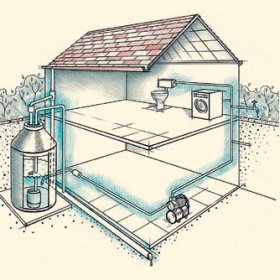
The comfort of suburban life largely depends on communications, including the autonomous water supply system. Typically, water is taken from a well or a well located on the territory of a suburban area, but sometimes this water is not enough, and additional, backup sources must be found. One of them is the collection of rainwater from the roof of a house, bathhouse or utility room.
Content
Benefits of Using Rainwater
If a country house is a permanent place of residence of a person, then to serve his needs about 130-160 liters of clean water are needed every day. A large amount of liquid goes to watering flower beds, beds, lawn. It becomes clear why rainwater will never be superfluous.
Recall summer souls in the country. In a large tank raised above the ground, water accumulates. Under the sun, it heats up and becomes comfortable to use on a hot day. If you slightly modify the primitive water supply system, then you can get water supply not only for the soul, but for the whole country house.
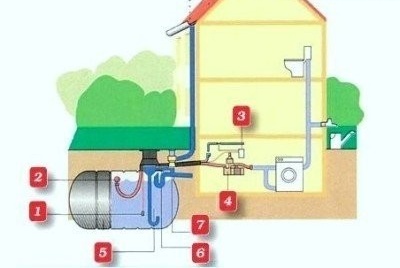
Rainwater harvesting systems: 1 - water level sensor; 2 - float filter; 3 - water level control; 4 - centrifugal pump; 5 - capacity made of polyethylene; 6 - siphon; 7 - filter
Is the water collected after rain suitable for washing or even showering? Of course! In its chemical composition, it is much milder and safer than city tap water. A sufficient amount of oxygen in the composition makes it ideal for watering plants. Only in one case, precipitation can be harmful - if there is an industrial enterprise or a big city nearby.
Attention! Water collected after rain cannot be used for drinking or cooking. It is suitable only for technical needs - washing, cleaning, watering, washing the car. Or it must be passed through a serious cleaning system.
One of the advantages of rain collection is that it requires virtually no investment: you only need to spend money once on installing a tank and laying pipes. The only negative is the dependence on the amount of precipitation. In a dry summer, you do not have to rely on an additional source.

When installing the storage tank, do not forget about insurance against excess water. In the upper part of the tank, make a drain leading to the sewer, through which the excess flows
Choosing the right roof for the system
Not every building or house is suitable for collecting water, since the roof configuration and roofing material affect the quality of the liquid. Flat roofs are recommended to be immediately excluded for two reasons:
- rainwater is devoid of natural discharge;
water stagnates on the roof surface in the form of puddles, which are a hotbed of bacteria.
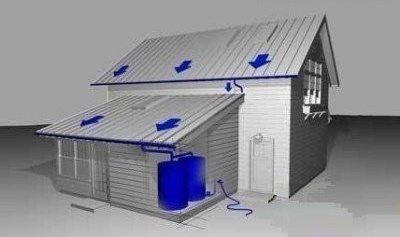
On any sloping roof, you can equip a water collection system using a structure assembled from gutters, downpipes, connectors and fasteners
Thus, the rainwater collection system is installed on buildings with a gable or gable roof with a certain slope, the best option is from 10 ° or more. Water flows down a steep roof much faster, therefore, it does not have time to get polluted.
Attention! Some roofing materials contain substances harmful to human health - copper, lead, asbestos. Do not collect water from roofs covered with asbestos slate or copper tiles. Gutters and drains containing copper or lead are also excluded.
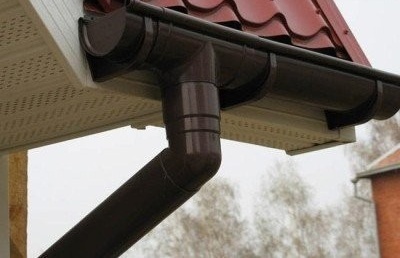
Modern modular gutters made of plastic are absolutely safe, in addition, they not only serve to collect water, but also are a decorative element of the building
Clay tiles, galvanized metal and modified plastic, from which modern gutters are made, will keep rainwater clean. Relatively safe and bituminous coatings.
Installation of a water collection system
In order for water from the roof to fall into the pipes, and from them to the points of disassembly in the house and outside, it is necessary to consider a system in which the initial accumulation and subsequent wiring are provided. The main components of the system are storage and plumbing.
Installation of storage tank
A water collection tank is needed to maintain the proper level of fluid in the system. As a rainwater storage tank, you can use any tank made of safe material: concrete, polyethylene, galvanized steel. The main property of the material for the production of the drive is stability, it should not dissolve in water and change its chemical composition.
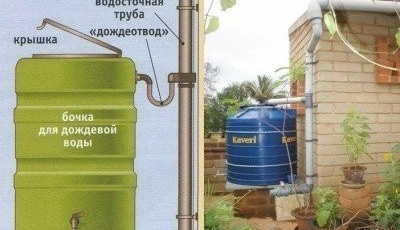
Installing a storage tank on the surface of the earth near the house has two advantages: you do not need to dig a special pit and you can use water for irrigation without using a pump
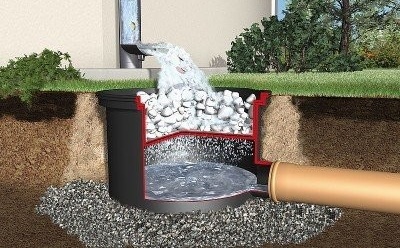
A rainwater collection tank installed in the ground is the best option from an aesthetic point of view. Moreover, the water in the cold earth will never "bloom"
There are several ways to install a storage tank:
- install directly under the drainpipes on the surface of the earth;
- bury in the ground near the house;
- arrange in a basement or utility room.
The preferred option is to place the tank in the ground, as the coolness inhibits the development of microorganisms. But two points must be taken into account: the level of soil freezing and the level of groundwater location. If all conditions are satisfactory, it is necessary to select the capacity. It is better to stay on a large volume (2-3 thousand liters), so that there is always a supply.
The drive is installed according to the following algorithm:
- We tear out the pit. Its dimensions should be slightly larger than the dimensions of the drive.
- At the bottom of the pit we arrange a sand cushion 20 cm thick.
- Lower the water tank.
- We fill the voids on all sides of the tank with sand.
- We install pipes and a pump.
- Close the neck of the tank with a lid.
When the cold comes, you should take care of the safety of the system until the next season. The pump should be removed, cleaned and stored in a warm room, and the lid of the container should be tightly sealed and covered with a thick layer of sand from above, thereby protecting it from freezing.
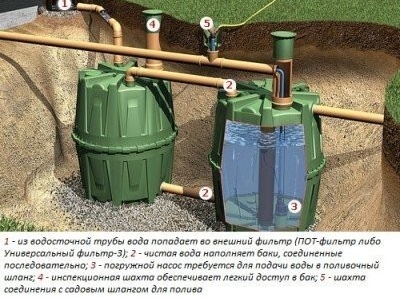
Instead of one large reservoir, several containers can be placed in the ground, interconnected by pipes. Having thought over the water filtration system, it is possible to arrange additional cleaning
Plumbing device
In order for water to flow from the drain into the tank, and from it into the house, it is necessary to lay a pipeline. Standard PVC outdoor products are great.Water flows naturally from the roof into the tank, as it is lower, but it is forced to enter the house, that is, by means of a pump. If a centrifugal pump is used, its installation location should be near the storage tank - as low as possible.
A small submersible pump is also suitable.
Attention! Installing the pump on the surface of the water ensures its cleanliness, since sediment accumulates over time at the bottom of the tank.
Proper equipment care
To use rainwater in the house, it must be at least clean, therefore, an infrequent but mandatory supervision of the system is required. For example, it should be protected from debris and dust that accumulate on the roof, rain drains falling into the storage tank. The first rain after a long drought serves as a kind of "sink" for the roof and gutters. Dirt, together with the first streams of water, rushes from the roof into the gutters and pipes, so the water inlet leading to the tank needs to be disconnected for a while. About an hour later, clean water will go - the pipe can be returned to its place.

Many modern gutters are initially equipped with devices for delaying large debris: nets with small cells that are located along the gutters and at the junction with pipes
Also, for the purification of water from large debris and leaves throughout the system, coarse filters are installed in the form of gratings and mesh baskets. As clogged, filters must be cleaned.
By installing a rainwater collection system in a country house, you will receive an additional source of water, and this is another step towards a comfortable life.
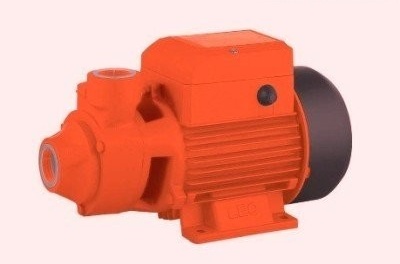



3 comments